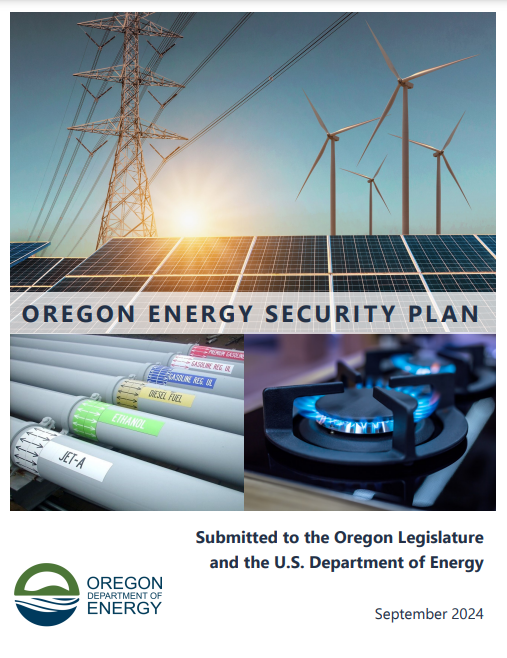The Oregon Department of Energy published the Oregon Energy Security Plan in September 2024 following direction from the federal government and
SB 1567. The plan identifies risks to electricity, liquid fuel, and natural gas/propane systems, and proposes ways to mitigate those risks.

Using funding from the federal government’s
Infrastructure Investment and Jobs Act (IIJA), the Oregon Department of Energy led a coordinated effort with other state agencies, the U.S. DOE, county and local governments, tribal governments, citizen groups, utilities, nonprofit organizations, businesses and industry leaders, and the public
to develop and implement Oregon’s Energy Security Plan. It will act as a living resource and be reviewed and updated regularly. ODOE welcomes
comments and feedback on the plan.
Thanks to our contractors, Haley & Aldrich and CNA, for their expertise.
Project Background
Oregon has talented and dedicated scientists and emergency planners who assess needs and develop plans to respond and recover from emergencies. The 2024 Oregon Energy Security Plan process brought together existing relevant threat information for electricity, liquid fuels, and natural gas systems and collected new data to fill data gaps.
Alongside the plan is a
risk assessment and
mitigation measures that can be implemented to reduce risk and improve Oregon's energy security. State, local governments, and Tribes — in collaboration with energy providers, nonprofit organizations, and all Oregonians — can use the information in the plan to better prepare for supply disruptions and make more informed decisions related to energy systems and infrastructure investments, resilience and hardening strategies, and asset management.
ODOE also developed, with support from partners and project contractors, a geospatial screening tool to assess the viability of existing fuel storage sites as potential candidates for fuel diversification and increased storage.
Learn more about the tool.
Stakeholder Engagement
To ensure the plan serves all Oregonians, ODOE conducted outreach to gather stories and data from all regions, economic sectors, and walks of life – seeking feedback from stakeholders and Tribal Nations throughout the project. ODOE held virtual and hybrid meetings in each of the regions of the state shown below. Stakeholders were also encouraged to submit comments and express interest in getting involved through our
online portal.
Meetings
Southwest Region
Thursday, May 23, 2024 | 9 - 11 a.m.
Jackson County Library Services - Medford Branch
Adams Conference Room
205 South Central Ave
Medford, OR 97501
Meeting Recording
|
Meeting Presentation
Meeting Handout
|
Willamette Valley Region
Wednesday, May 22, 2024 | 9 - 11 a.m.
ODOE Office
Meitner Conference Room
550 Capitol St NE
Salem, OR 97301
Meeting Recording
|
Meeting Presentation
Meeting Handout
|
Cascades Region
Tuesday, May 21, 2024 | 10 a.m. - 12 p.m.
ODOT Region 4 HQ, Building M, Tammy Baney Conference Room
63055 North Highway 97
Bend, OR 97703
Meeting Recording
|
Meeting Presentation
Meeting Handout
|
Eastern Region
Thursday, May 16, 2024 | 9 - 11 a.m.
City Hall Community Room
500 SW Dorion Ave
Pendleton, OR 97801
Meeting Recording
|
Meeting Presentation
Meeting Handout
|
Tribal Governments
Thursday, May 16, 2024 | 1 - 3 p.m.
Confederated Tribes of the Umatilla Indian Reservation (CTUIR)
|
Meeting Presentation
Meeting Handout
|
Portland Metropolitan Region
Wednesday, May 15, 2024 | 10 a.m. - 12 p.m.
University of Oregon - Portland
Room 152
70 NW Couch Street Portland, OR 97209
Meeting Recording
| Meeting Presentation
Meeting Handout
|
Northwest Region
Tuesday, May 14, 2024 | 1 - 3 p.m.
Tillamook County Library 1716 Third Street
Tillamook, OR 97141
| Meeting Presentation
Meeting Handout
|
|
Statewide Kick-Off Webinar
October 16, 2023 | 12:30-2:00
Meeting Recording
|
Meeting Presentation
|
Additional Background
Oregon’s energy sector consists of electricity, liquid fuels, and natural gas assets that are geographically dispersed and connected by systems and networks across our state and region. The energy sector is uniquely vital as all other critical infrastructure and lifeline services depend on power and liquid fuels to operate. Oregon’s energy infrastructure and delivery systems are vulnerable to a variety of
hazards, including severe weather (flooding, wildfires, earthquakes, etc.), systems and infrastructure failures, pandemics, deliberate physical or cyber attacks, and other events. Whatever the cause, when the demand for energy is greater than the available supply, energy insecurity is created. A disruption in the critical energy infrastructure can directly affect the security and resilience within the energy sectors and across other critical infrastructure systems – transportation, communications, and water – threatening public health and safety, the environment, the region’s economy, and perhaps our national security.
The Oregon Energy Security Plan is intended to help the state plan for, respond to, and recover from events that disrupt energy supply (electricity, natural gas, liquid fuels, etc). Through efforts to quantify and mitigate risks to energy infrastructure, ODOE is working to ensure a reliable and resilient supply of energy at an affordable price.